Other White
The term Other White, or White Other, is a classification of ethnicity in the United Kingdom used in documents, such as the 2011 UK Census, to describe people who self-identify as white (chiefly European) persons who are not of the English, Welsh, Scottish, Romani or Irish ethnic groupings.
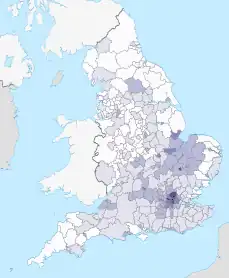 Distribution by District (2011) | |
| Total population | |
|---|---|
| 2,690,088 4.25% of the total population (2011 census) | |
| Regions with significant populations | |
| London, East of England, Greater Manchester, Peterborough, Nottingham, Reading, Boston | |
| Languages | |
| British English, Polish, Romanian, Italian | |
| Religion | |
| Predominantly Christianity; Minorities practice Irreligion, Judaism and Islam | |
| Related ethnic groups | |
| White British, White Polish, Romanians in the United Kingdom |
The category does not comprise a single ethnic group but is instead a method of identification for white people who are not represented by other white census categories. This means that the Other White group contains a diverse collection of people not of British, Irish or Romani descent, or with different countries of birth.
In 2011, the Scottish Government introduced the category White Polish to differentiate Polish Britons, and Polish residents, living in Scotland from this broad grouping.
The categorisation was primarily intended to cover people with that have descended or migrated from Continental Europe, with the largest represented ethnic groups being Poles (except in Scotland since 2011), Germans, Romanians, Italians and the French.[2][3] However, white people from outside of the continent, are also represented in the White Other category.
Along with White British and White Irish, the category does not appear in Northern Ireland, where only one single "White" classification was presented to respondents.[4]
According to the 2021 United Kingdom census, those identifying as Other White in England & Wales enumerated 3,667,997, or 6.2% of the population.[5][6]
Demographics
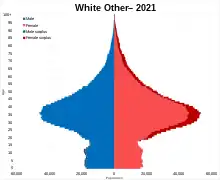
Birthplace
Year of arrival (2021 census)[7]
According to 2016 ONS Estimates, Other Whites enumerated 4,167,000, or 6.3% of the population in the United Kingdom.[8] However their numbers, in line with a slight population decline in Polish and Romanian citizens in Britain, fell to 3,667,997 in England & Wales at the 2021 United Kingdom census.[9][10]
In the 2001 UK Census, the majority of people living in England and Wales ticking the 'Other White' ethnic group specified their ethnicity as European.[11] Four out of five of the 'Other White' category (i.e. not British or Irish) were born overseas. A third were born in a Western European country other than the UK, and one in seven were born in an Eastern European country.[11]
Outside of Europe, countries derived from former British colonies such as the Canada, Australia, New Zealand, South Africa and United States were among the top ten birthplaces (which included the UK itself). This suggested that, in 2001, significant numbers of Canadian Britons, Australian Briton, New Zealand Britons, American Britons and South African Britons, such as those born abroad to British parents and returned to the UK as minors, identified as White Other. It may also be that those who identify as white Canadians, white Australians, white New Zealanders, white Americans or white South Africans white Australians have migrated to the country as adults.[11]
According to 2016 ONS Estimates, Other Whites enumerated 4,167,000, or 6.3% of the population in the United Kingdom.[8] However their numbers, in line with a slight population decline in Polish and Romanian citizens in Britain, fell to 3,667,997 in England & Wales at the 2021 United Kingdom census.[9][10]
Economic status
The Other White group is largely of working age, with only one in ten aged over 65 and one in seven under 16 at the time of the 2001 census. This does vary according to the stated country of birth, with people born in the UK being disproportionately young. Polish and Italian respondents had a larger proportion of over 65s,[11] which reflects the migration of Poles and Italians to Britain after the Second World War.
In 2019, the Other White group had a median hourly pay of £11.54 (8% less than the White British group).[12]
In 2021, the Other White group had an employment rate of 82% - the highest in England, Scotland and Wales.[13]
According to a 2022 Civitas report, Other White citizens have average wealth or assets of £53,200.[14]
| Ethnic group | Individual median wealth |
|---|---|
| White British | £166,700 |
| Indian | £144,400 |
| Black Caribbean | £85,000 |
| Chinese | £67,300 |
| White Other | £53,200 |
| Pakistani | £52,000 |
| Bangladeshi | £22,800 |
| Black African | £18,100 |
Religion
| Religion | England and Wales | |||
|---|---|---|---|---|
| 2011[15] | 2021[16] | |||
| Number | % | Number | % | |
| 1,617,833 | 65.08% | 2,202,595 | 60.05% | |
| No religion | 464,911 | 18.70% | 933,703 | 25.46% |
| 131,056 | 5.27% | 131,425 | 3.58% | |
| 39,319 | 1.58% | 49,125 | 1.34% | |
| 9,275 | 0.37% | 9,658 | 0.26% | |
| 4,740 | 0.19% | 1,368 | 0.04% | |
| 1,795 | 0.07% | 607 | 0.02% | |
| Other religions | 11,749 | 0.47% | 31,925 | 0.87% |
| Not Stated | 205,134 | 8.25% | 307,587 | 8.39% |
Detailed breakdown
| Ethnic group within the White Other Group (in England and Wales) | 2021[17] | |
|---|---|---|
| Population | % | |
| White: European Mixed | 646,118 | 1.1 |
| White: Polish | 614,344 | 1.0 |
| White: Romanian | 342,651 | 0.6 |
| White: Other White, White unspecified | 211,287 | 0.4 |
| White: Other Eastern European | 166,179 | 0.3 |
| White: Italian | 148,661 | 0.2 |
| White: Lithuanian | 97,217 | 0.2 |
| White: Portuguese | 93,608 | 0.2 |
| White: Bulgarian | 89,546 | 0.2 |
| White: North American | 82,985 | 0.1 |
| White: Spanish | 81,150 | 0.1 |
| White: French | 78,502 | 0.1 |
| White: Greek | 73,719 | 0.1 |
| White: German | 66,174 | 0.1 |
| White: Hungarian | 65,697 | 0.1 |
| White: Australian/New Zealander | 61,172 | 0.1 |
| White: Turkish | 61,102 | 0.1 |
| White: South African | 57,648 | 0.1 |
| White: Latvian | 48,070 | 0.1 |
| White: Russian | 44,662 | 0.1 |
| White: Albanian | 40,879 | 0.1 |
| White: Slovakian | 36,936 | 0.1 |
| White: Jewish | 34,105 | 0.1 |
| White: Hispanic or Latin American | 32,335 | 0.1 |
| White: Greek Cypriot | 29,472 | 0.0 |
| White: Czech | 25,023 | 0.0 |
| White: Brazilian | 24,221 | 0.0 |
| White: Dutch | 23,721 | 0.0 |
| White: Any other ethnic group | 22,309 | 0.0 |
| White: Other Mixed | 21,092 | 0.0 |
| White: Mixed Irish | 20,278 | 0.0 |
| White: White African | 20,273 | 0.0 |
| White: Ukrainian | 16,297 | 0.0 |
| White: Swedish | 16,132 | 0.0 |
| White: Kosovan | 13,145 | 0.0 |
| White: Danish | 9,453 | 0.0 |
| White: Turkish Cypriot | 9,398 | 0.0 |
| White: Serbian | 7,906 | 0.0 |
| White: Finnish | 7,892 | 0.0 |
| White: Belgian | 7,576 | 0.0 |
| White: Iranian | 7,356 | 0.0 |
| White: Swiss | 7,005 | 0.0 |
| White: Croatian | 6,995 | 0.0 |
| White: Norwegian | 6,814 | 0.0 |
| White: South American | 6,600 | 0.0 |
| White: Other Middle East | 6,527 | 0.0 |
| White: Cypriot (part not stated) | 5,956 | 0.0 |
| White: Austrian | 5,825 | 0.0 |
| White: Estonian | 5,147 | 0.0 |
| White: Kurdish | 5,091 | 0.0 |
| White: Maltese | 4,971 | 0.0 |
| White: Arab | 3,931 | 0.0 |
| White: Armenian | 3,807 | 0.0 |
| White: Slovenian | 3,719 | 0.0 |
| White: White Caribbean | 3,469 | 0.0 |
| White: Macedonian | 3,446 | 0.0 |
| White: Other North African | 3,375 | 0.0 |
| White: Moldovan | 3,207 | 0.0 |
| White: Mixed White | 2,991 | 0.0 |
| White: Israeli | 2,981 | 0.0 |
| White: African unspecified | 2,805 | 0.0 |
| White: Bosnian | 2,633 | 0.0 |
| White: Belarusian | 2,522 | 0.0 |
| White: Argentinian | 2,156 | 0.0 |
| White: Georgian | 2,149 | 0.0 |
| White: White and North African or Middle Eastern | 2,035 | 0.0 |
| White: Colombian | 1,976 | 0.0 |
| White: Zimbabwean | 1,803 | 0.0 |
| White: Algerian | 1,776 | 0.0 |
- Other White ethnic groups with above 50,000 population as population pyramids in 2021
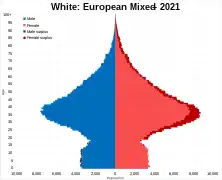 White European Mixed
White European Mixed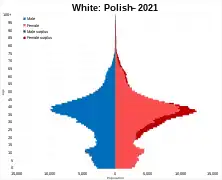 White Polish
White Polish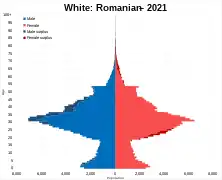 White Romanian
White Romanian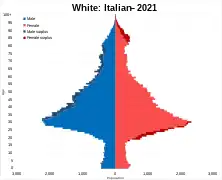 White Italian
White Italian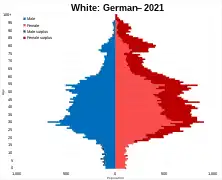 White German
White German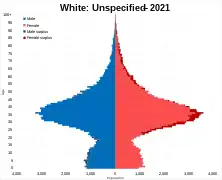 White: Other White or White Unspecified
White: Other White or White Unspecified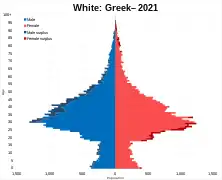 White Greek
White Greek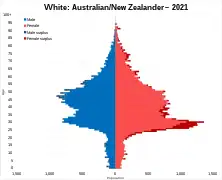 White Australian+New Zealander
White Australian+New Zealander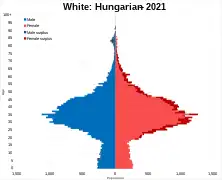 White Hungarian
White Hungarian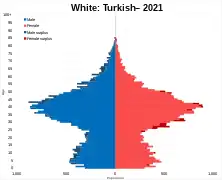 White Turkish
White Turkish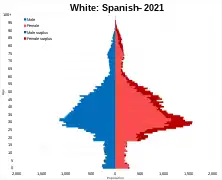 White Spanish
White Spanish White South African
White South African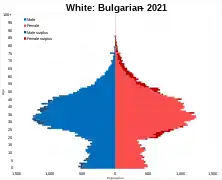 White Bulgarian
White Bulgarian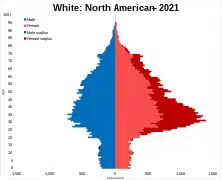 White North American
White North American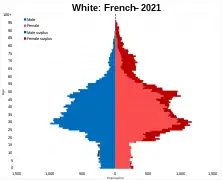 White French
White French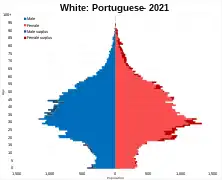 White Portuguese
White Portuguese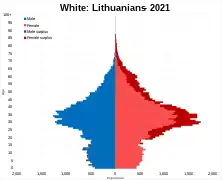 White Lithuanians
White Lithuanians
See also
- Albanians in the United Kingdom
- Americans in the United Kingdom
- Australians in the United Kingdom
- Austrians in the United Kingdom
- Baltic people in the United Kingdom
- Bulgarians in the United Kingdom
- Canadians in the United Kingdom
- Classification of ethnicity in the United Kingdom
- Czechs in the United Kingdom
- Dutch people in the United Kingdom
- British Jews
- Germans in the United Kingdom
- Greeks in the United Kingdom
- Hungarians in the United Kingdom
- Italians in the United Kingdom
- History of the Jews in the United Kingdom
- Kosovans in the United Kingdom
- New Zealanders in the United Kingdom
- Poles in the United Kingdom
- Portuguese in the United Kingdom
- Romanians in the United Kingdom
- Russians in the United Kingdom
- Scandinavian migration to Britain
- Serbs in the United Kingdom
- Slovenes in the United Kingdom
- South Africans in the United Kingdom
- Spaniards in the United Kingdom
- Swedes in the United Kingdom
- Turkish people in the United Kingdom
References
- "2021 Census: Ethnic group, local authorities in the United Kingdom". Office for National Statistics. Retrieved 29 November 2022.
- 2011 Census: KS202EW National identity, local authorities in England and Wales, Accessed 22 December 2012
- "Population of the UK by Country of Birth and Nationality: 2015". Office for National Statistics – Table 2: Five most common non-UK countries of birth and non-British nationalities for usual residents of the UK, 2017. Retrieved 9 June 2017.
- "Harmonised Concepts and Questions for Social Data Sources: Primary Standards – Ethnic Group" (PDF). Office for National Statistics. April 2008. Archived from the original (PDF) on 7 January 2010. Retrieved 21 August 2010.
- "Ethnic group, England and Wales - Office for National Statistics". www.ons.gov.uk. Retrieved 2022-11-29.
- "Ethnic group - Census Maps, ONS". www.ons.gov.uk. Retrieved 2022-11-29.
- "Ethnic group and year of arrival in the uk - Office for National Statistics". www.ons.gov.uk. Retrieved 2023-07-08.
- "Research report on population estimates by characteristics - Office for National Statistics". www.ons.gov.uk. Retrieved 2022-11-30.
- "Ethnic group, England and Wales - Office for National Statistics". www.ons.gov.uk. Retrieved 2022-11-30.
- "UK Loses EU Nationals in a Year of Brexit and Pandemic Shocks". Bloomberg.com. 2022-05-26. Retrieved 2022-11-30.
- Gardener, David; Connolly, Helen (October 2005). "Who are the 'Other' ethnic groups?" (PDF). Office for National Statistics. Archived from the original (PDF) on May 28, 2008. Retrieved 22 June 2008.
- "Ethnicity pay gaps - Office for National Statistics". www.ons.gov.uk. 12 October 2020. Retrieved 8 March 2023.
- "Employment". www.ethnicity-facts-figures.service.gov.uk. 3 November 2022. Retrieved 8 March 2023.
- Norrie, Richard (February 2022). "In defence of British openness" (PDF). Retrieved 15 March 2023.
- "DC2201EW - Ethnic group and religion" (Spreadsheet). ONS. 15 September 2015. Retrieved 14 January 2016. Size: 21Kb.
- "Ethnic group by religion - Office for National Statistics". www.ons.gov.uk. Retrieved 2023-04-02.
- "Ethnic group (detailed) - Office for National Statistics". www.ons.gov.uk. Retrieved 2023-01-25.